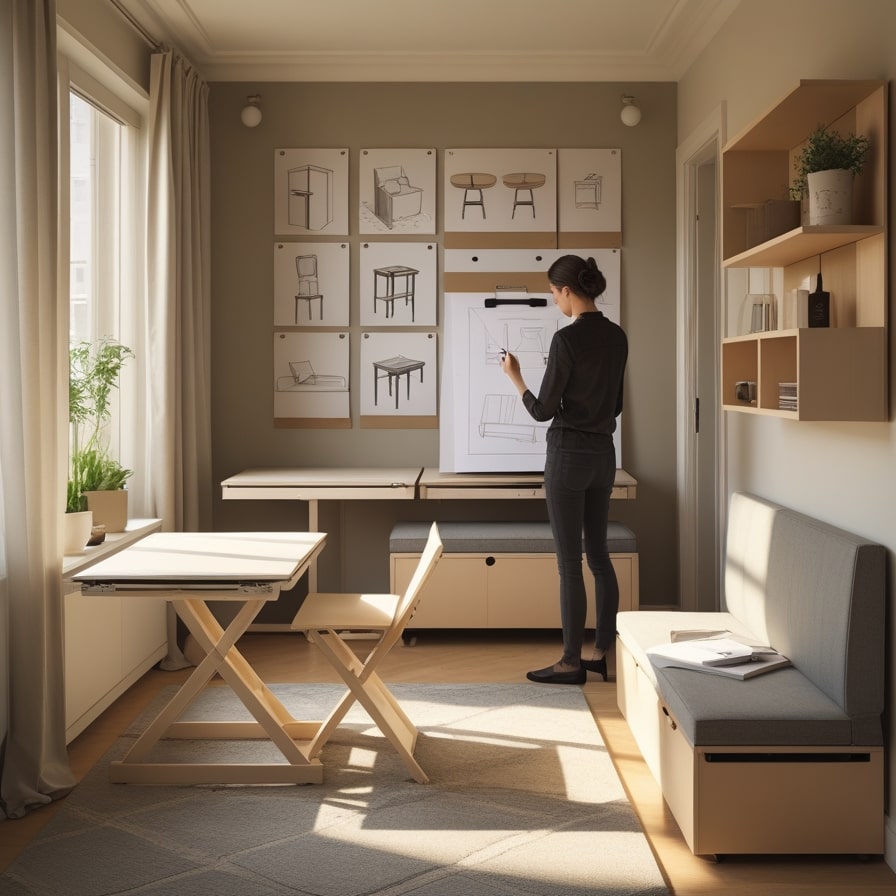Designing furniture for small spaces requires careful planning and a touch of creativity.
With limited room to work with, every piece of furniture must be functional, space-efficient, and visually appealing.
Whether you’re furnishing a compact apartment or creating storage solutions for a tiny room, a well-thought-out plan can make all the difference.

Assessing Your Space and Needs
The first step in planning furniture for small spaces is understanding the area you’re working with. Measure the dimensions of the room, noting any architectural features like windows, doors, and built-in elements.
These details will help you visualize how much usable space you have and where furniture can be placed without obstructing movement or natural light.
Next, identify your priorities. What do you need the furniture to accomplish? For instance, in a small living room, you may want seating that doubles as storage. In a bedroom, you might require a bed with built-in drawers.
By listing your essential needs, you can focus on creating pieces that solve specific problems while maximizing functionality.
Choosing Multi-Functional Designs
In small spaces, every piece of furniture should serve more than one purpose. Multi-functional designs are key to saving space and adding versatility to a room.
Consider creating a coffee table that doubles as a storage chest or a dining table that can fold away when not in use.
Wall-mounted furniture, like foldable desks or floating shelves, can free up floor space while still providing utility.
Another effective approach is incorporating built-in storage into your designs. Beds with drawers, sofas with hidden compartments, and benches with lift-up lids are excellent examples of how to combine form and function.
These designs not only save space but also help keep your room organized and clutter-free.
Prioritizing Vertical Space
When floor space is limited, look up. Utilizing vertical space is an essential strategy for planning furniture in small areas.
Tall bookshelves, wall-mounted cabinets, and pegboards are great ways to add storage without encroaching on your walking area.
Custom-built units that extend to the ceiling can make the most of unused vertical space while adding a sense of height to the room.
If you’re designing furniture for a specific area, like a kitchen or workspace, consider incorporating hanging elements.
Hooks, magnetic strips, or suspended shelves can hold items that would otherwise take up valuable counter or tabletop space.
Opting for Lightweight and Modular Pieces
Furniture for small spaces should be easy to move and adaptable to different configurations. Lightweight materials, such as plywood or metal, can make pieces more manageable while maintaining durability.
Modular furniture is particularly useful because it can be reconfigured to suit different needs. For example, a modular sofa can be rearranged to create additional seating or sleeping space, depending on the occasion.
Additionally, furniture on wheels is a practical choice for small spaces. Rolling carts, mobile desks, or wheeled storage units can be easily moved around to accommodate various activities, adding flexibility to your living area.
Focusing on Aesthetics and Proportions
In small spaces, the visual impact of furniture is just as important as its functionality. Overly bulky or dark-colored pieces can make a room feel cramped and overwhelming.
Instead, opt for slim, streamlined designs in lighter tones that create an open and airy feel.
Glass or acrylic furniture, like transparent coffee tables or chairs, can also help maintain a sense of spaciousness.
Proportion is another critical factor. Avoid oversized furniture that dominates the room. Instead, select pieces that complement the scale of the space.
For example, a compact loveseat can provide ample seating without overwhelming a small living room, while a narrow dining table can fit snugly into a kitchenette.
Planning with Flexibility in Mind
Small spaces often require furniture that can adapt to changing needs. When planning your projects, think about how the pieces might be used in different scenarios.
A Murphy bed, for instance, can free up floor space during the day and provide comfortable sleeping arrangements at night.
Extendable tables and stackable chairs are other versatile options that offer flexibility for entertaining or everyday use.
Investing in furniture that can evolve with your space ensures that your designs remain practical and functional over time.
By thinking ahead, you can create pieces that continue to meet your needs even if your living situation changes.
Final Thoughts
Planning furniture projects for small spaces involves a balance of creativity, practicality, and thoughtful design.
By assessing your needs, prioritizing multi-functional and modular elements, and paying attention to aesthetics, you can transform even the smallest of spaces into a stylish and efficient haven.
With the right approach, small spaces can feel expansive and inviting, proving that good design truly knows no size limits.